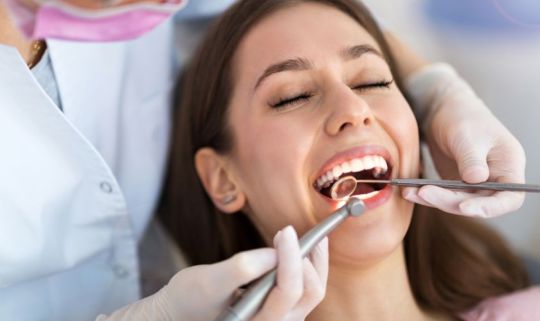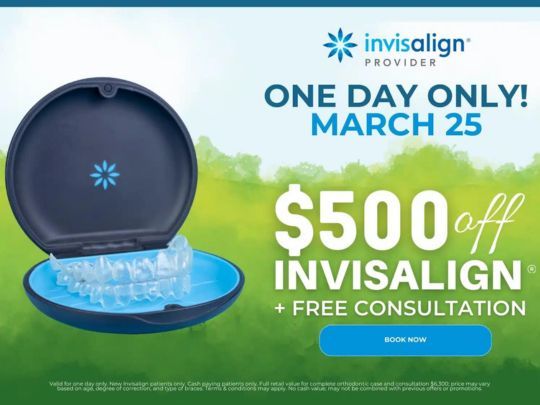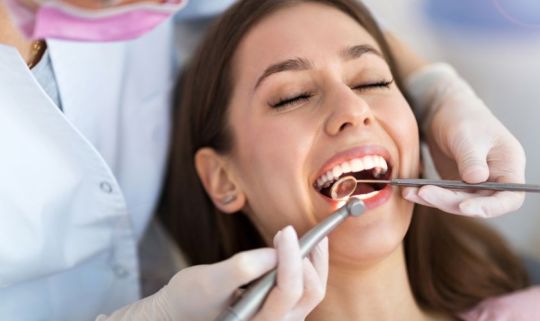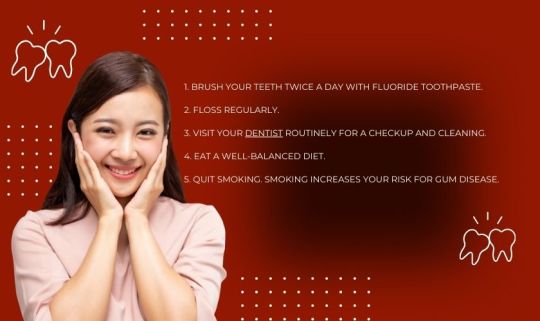Text
How Often Should You Schedule Teeth Cleaning and Exams
Regular dental care is essential for a bright smile and overall health. But how often should you schedule teeth cleaning and exams in Tempe, AZ? Let's dive into the specifics to ensure your dental health stays in top shape. Keep reading to understand the role of a dentist in oral health evaluation and keeping your teeth in top condition.

Importance of Regular Teeth Cleaning
Teeth cleaning removes plaque and tartar buildup that regular brushing misses. Professional cleanings prevent cavities, gum disease, and bad breath. They also leave your teeth looking and feeling fresh.
Recommended Frequency for Adults
Most dentists recommend teeth cleaning and exams every six months. This schedule helps maintain oral health and catch issues early. Some people may need more frequent visits, especially if they have dental issues. Your dentist will advise you on the best schedule to meet your needs.
Why Children Need Regular Dental Visits?
Children's teeth are more susceptible to cavities. Starting dental visits early helps prevent decay and instills good habits. Pediatric dentists often recommend cleanings every six months. This frequency helps monitor growth and address any concerns early on.
Special Cases Requiring More Frequent Visits
Certain conditions necessitate more frequent dental visits. People with gum disease, diabetes, or a history of cavities might need cleanings every three to four months. Your dentist in Tempe, AZ, will create a customized plan to suit your dental health.
What Happens During a Dental Exam?
A dental exam involves more than just cleaning. Your dentist checks for cavities, gum disease, and oral cancer. X-rays may be taken to detect issues not visible to the naked eye. This comprehensive approach ensures any problems are caught and treated early.
The Role of Dental Hygienists
Dental hygienists play a crucial role in your oral health. They perform cleanings, remove plaque, and provide education on proper oral care. Their expertise complements the dentist’s work, ensuring a thorough and effective dental visit.
Benefits of Regular Dental Visits
Regular visits help maintain a healthy mouth and detect issues early. They prevent costly and extensive treatments down the line. Consistent dental care contributes to overall well-being, as oral health impacts your entire body.
Signs You Need a Dental Visit Sooner
Sometimes, waiting for your regular appointment isn’t wise. If you notice bleeding gums, persistent bad breath, or tooth pain, schedule a visit immediately. These signs could indicate underlying issues needing prompt attention.
Tips for Maintaining Oral Health Between Visits
Daily brushing and flossing are essential. Use fluoride toothpaste and replace your toothbrush every three months. Limit sugary foods and drinks, as they contribute to decay. Rinse your mouth with water after eating if brushing isn’t possible.
Choosing the Right Dentist for Your Needs
Find a dentist you trust and feel comfortable with. Look for recommendations from friends and family. Check online reviews and ensure the dentist is experienced and certified. A good relationship with your dentist makes regular visits more pleasant.
The Cost of Teeth Cleaning and Exams
The cost of dental visits varies, but insurance often covers preventive care. Without insurance, cleanings can range from $75 to $200. Investing in regular cleanings saves money in the long run by avoiding expensive treatments.
Overcoming Dental Anxiety
Dental anxiety is common but manageable. Talk to your dentist about your fears. They can offer sedation options or distraction techniques. Regular visits build familiarity, reducing anxiety over time.
Scheduling regular teeth cleaning and exams in Tempe, AZ is crucial for a healthy smile. Follow your dentist’s recommendations, and don’t ignore any warning signs. Consistent dental care ensures your teeth and gums stay in great shape, contributing to your overall well-being. Prioritize your oral health for a lifetime of smiles at Do Good Dental, your premier destination for tailored care!
0 notes
Text
0 notes
Text

0 notes
Text
Relax and Rest Assured: Can You Feel Pain During Sedation Dentistry?
Dental anxiety is a common concern, often leading people to postpone or avoid necessary dental procedures. But what if there was a way to experience dentistry comfortably and with minimal discomfort? Sedation dentistry offers a solution, but a lingering question remains: can you feel pain during sedation dentistry? This blog explores the world of sedation dentistry, explaining different levels of sedation and how they impact pain perception.

Understanding Sedation Dentistry
Sedation dentistry utilizes various medications to induce relaxation and reduce anxiety during dental procedures. Unlike general anesthesia, which renders you completely unconscious, sedation dentistry allows you to remain partially conscious and responsive to your surroundings.
Levels of Sedation Dentistry and Pain Management
There are three main levels of sedation dentistry, each offering a different level of relaxation and pain management:
Minimal Sedation (Laughing Gas): Nitrous oxide, also known as laughing gas, is a common form of minimal sedation. It's inhaled through a mask and induces a sense of lightheadedness and euphoria. You'll likely remain responsive to the dentist's instructions and might feel some discomfort, but the relaxed state significantly reduces pain perception.
Moderate Sedation: This level utilizes oral medications like triazolam or diazepam (Valium) to induce a deeper state of relaxation. You might feel drowsy and have minimal memory of the procedure. Pain perception is significantly reduced, and the dentist might administer local anesthesia for additional pain control during specific procedures.
Deep Sedation (Intravenous Sedation): This deeper level of sedation is administered intravenously (through a vein). While you remain conscious, you'll be very relaxed and might have little to no memory of the procedure. Pain perception is significantly reduced or eliminated, and local anesthesia might also be used for added comfort.
Important Note: It's crucial to disclose any medical conditions and medications you're taking to your dentist before undergoing sedation dentistry. This information helps them determine the most appropriate level of sedation for your safety and comfort.
Beyond Pain Management: Benefits of Sedation Dentistry
Sedation dentistry offers several benefits beyond pain management:
Reduced Anxiety: For individuals with high dental anxiety, sedation dentistry allows them to undergo necessary procedures without overwhelming fear or discomfort.
Increased Comfort: The relaxed state induced by sedation makes the dental experience more manageable and comfortable.
Gag Reflex Control: For patients with a strong gag reflex, sedation can help minimize its activation during procedures.
Faster Procedures: Sedation can help patients remain still throughout the procedure, allowing the dentist to work more efficiently.
Who is a Good Candidate for Sedation Dentistry?
Sedation dentistry can be beneficial for a variety of patients, including:
Individuals with dental anxiety or fear of needles
Patients with a strong gag reflex
People who require extensive dental procedures
Those who have difficulty getting numb with local anesthesia alone
Safety First: Considerations and Aftercare
While sedation dentistry is generally safe with proper monitoring, there are some considerations:
Monitoring: Your vital signs (heart rate, oxygen levels) will be closely monitored throughout the procedure by a qualified professional.
Recovery: After sedation, you might experience drowsiness and require a ride home. Plan for someone to accompany you and monitor you until the effects of the sedation wear off.
A Relaxed Path to a Healthy Smile
Sedation dentistry can significantly enhance your dental experience, offering a comfortable and anxiety-free approach to achieving a healthy smile. By understanding the different levels of sedation and their impact on pain perception, you can feel empowered to discuss your options with your dentist and choose the approach that best suits your needs. Remember, a relaxed and comfortable dental experience is just a conversation away!
0 notes
Text
0 notes
Text
0 notes
Text

Join us on March 25 for an exclusive one-day event – get $500 off on your Invisalign treatment. Don't miss this chance to align your teeth discreetly! Book now for a radiant grin that speaks volumes.
Dr.Chip Webb
2010 E Elliot Rd Suite 105
Tempe, AZ
85284
USA
4805615660
dogooddental.com
0 notes
Text
A Comprehensive Guide to the Benefits of Sedation Dentistry for Patients and Dentists
For many, the mere thought of a dental appointment induces anxiety and nervousness. If you find yourself among those who dread the dentist's chair, sedation dentistry might be the game-changer you've been searching for. In this blog post, we'll delve into the transformative benefits of sedation dentistry, offering both patients and dental professionals a pathway to a stress-free and efficient dental experience. So, sit back, relax, and let's explore the pain-free world of dentistry.

Understanding Sedation Dentistry:
Sedation dentistry, a specialized field within dental care, utilizes medication to induce relaxation during dental procedures. From routine cleanings to more complex treatments like root canals or extractions, sedation can be tailored to meet individual needs, ensuring a more comfortable and anxiety-free experience.
Benefits for Patients:
Anxiety Reduction and Enhanced Comfort: Sedation dentistry effectively addresses the anxiety and fear often associated with dental procedures. The medication used induces a relaxed state, helping patients feel more at ease throughout their appointments and reducing any associated pain or discomfort.
Efficient Pain Management: One of the primary advantages of sedation dentistry is its ability to manage pain effectively. Patients undergoing sedation will not feel any pain during their dental procedures, promoting a more comfortable and pain-free experience.
Faster Treatment Procedures: By inducing relaxation and eliminating anxiety, sedation dentistry allows for faster and more efficient treatment procedures. Dentists can work more quickly and accomplish multiple procedures in a single appointment, saving both time and resources.
Easier Dental Procedures: Sedation dentistry makes dental procedures easier for both patients and dentists. Patients are less likely to experience anxiety or pain, contributing to smoother procedures. Additionally, dentists may find it easier to work on patients who are sedated, as they are less likely to move or squirm during the treatment.
Increased Patient Comfort and Safety: Sedation dentistry caters to patients experiencing anxiety or fear during dental procedures, enhancing overall comfort and safety. With various sedation options available, dentists can work with patients to choose the most suitable type based on individual anxiety levels.
Benefits for Dentists:
Increased Efficiency and Production: Sedation dentistry allows dentists to increase efficiency by completing more procedures in a single day. The relaxed state of the patient enables dentists to work more quickly and effectively, contributing to enhanced productivity.
Building Trust with Anxious Patients: Sedation dentistry helps build trust with patients who may be apprehensive about dental work. By providing a comfortable and anxiety-free experience, dentists can establish a positive rapport with patients, encouraging regular dental visits.
Types of Sedation Dentistry:
Oral Sedation: Common and convenient, oral sedation involves taking a pill before the appointment, inducing drowsiness while keeping the patient awake.
IV Sedation: A more intense option, IV sedation requires a needle inserted into a vein to deliver medication, resulting in a semi-conscious state.
Nitrous Oxide: Also known as "laughing gas," nitrous oxide is inhaled through a mask, keeping patients conscious but relaxed during the procedure.
General Anesthesia: Reserved for more invasive procedures, general anesthesia renders patients completely unconscious, requiring assistance for transportation after the procedure.
Risks Associated with Sedation Dentistry:
While any medical procedure carries inherent risks, the risks associated with sedation dentistry are generally low and manageable. Common side effects may include temporary drowsiness, nausea (in a small percentage of patients), and extremely rare allergic reactions, which can be treated with antihistamines.
Sedation dentistry emerges as a beacon of comfort and efficiency for both patients and dentists alike. By alleviating anxiety, managing pain, and streamlining procedures, this innovative approach transforms dental visits into stress-free experiences. If you're contemplating sedation dentistry for your next appointment, engage in a discussion with your dentist to explore the available options. With the right sedation approach, you can embark on a journey to a more relaxed, enjoyable, and overall improved dental experience. Say goodbye to dental anxiety and hello to the ease of sedation dentistry!
0 notes
Text
0 notes
Text
0 notes
Text
0 notes

